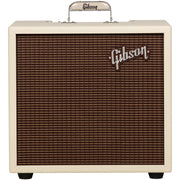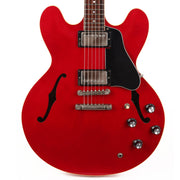Gibson And Epiphone Guitars Serial Number Guide
Wondering how old your Gibson or Epiphone guitar is? Maybe you have a Gibson banjo, dobro, or a Goldtone amplifier you’re not sure about. This serial number guide will help you to figure it all out. This guide, republished courtesy of Gibson.com, provides information from 1975-present, covering thousands of Gibson instruments. For instruments older than 1975, you’ll need to consult a Gruhn guide or one of the Blue Book PDFs available through Gibson’s site.
serial number information republished from Gibson.com:
Gibson USA, Gibson Acoustic, Gibson Memphis
– From 1975-1977 the number is typically found on a decal on the back of the headstock. This should be an 8 digit number that can be dated by the 1st and 2nd digits as follows:
99 = 1975
00= 1976
06 = 1977
– In 1977, Gibson introduced the serialization method that we primarily use to this day at Gibson USA, Gibson Acoustic, and the Gibson Custom facility in Memphis, TN.
The serial number will be an 8 digit number impressed into the back of the headstock with “MADE IN USA” below.
The pattern is as follows:
YDDDYRRR
YY is the production year
DDD is the day of the year
RRR is the factory ranking/plant designation number.
Prior to 1984 when the Kalamazoo, MI factory was closed, the numbers 001-499 indicated Kalamazoo production. Ranking numbers 500-999 continued to indicate Nashville production through 1989.
Since 1989, all Gibson acoustics are built in Bozeman, MT and all Gibson electrics are built in Nashville or Memphis. Ranking numbers for Bozeman start each day at 001 and the electrics may start as low as the 300s.
Examples: 70108276 means the instrument was produced on Jan. 10, 1978, in Kalamazoo and was the 276th instrument stamped that day.
82765501 means the instrument was produced on Oct. 3, 1985, in Nashville and was the 1st instrument stamped that day.
NOTE – Gibson USA goes to a 9 digit serial number in early July 2005..
The sixth number is now a batch number- batch 0 starts at the beginning of the day, and once we stamp 699, the batch number will change to 1. The first 5 numbers remain the same, the last 3 numbers will remain the same. The only difference is the addition of this batch indicator.
There are always exceptions to these rules, the two listed below are worth noting:
Les Paul Classic: This model features an ink stamped serial number with no “MADE IN USA” (just as we used on the original 1952-1960 Les Pauls). Most will be 5 to 6 digits in length, but the earliest examples feature 4 digit serial numbers. There should be a space after the 1st digit with the 4 and 5 digit serial numbers, and no space with the 6 digit numbers.
The 1st digit indicates the year of manufacture for the 4 & 5 digit serial numbers, these were used from 1989-1999. The 1st and 2nd indicate the year of manufacture for the 6 digit serial numbers which we’ve been using since 2000.
Examples –
9 xxx = 1989 (4 digit number beginning with “9” used only in 1989)
0 xxxx = 1990
9 xxxx = 1999
00xxxx = 2000
05xxxx = 2005
Those beginning with “94”:
In 1994, Gibson’s Centennial year, many instruments have a serial number that begins with “94” for the year, with the remaining 6 digits indicating the ranking number.
Gibson Custom
1952-1960 Les Paul, Explorer, Flying V, and Futura reissues (since late 1992):
M YRRR or MYRRRR
M is the model year being reissued
Y is the production year
RRR(R) indicates the guitar’s place production for that year. NOTE: This number includes all models for a particular reissue year – so, for example, a 1958 Reissue serial number may include ’58 Reissue LP Standard and ’58 Explorer production.
Example: 7 5123 is the 123rd 1957 reissue model produced in 2005.
1961-1969 Firebird, Les Paul, and SG reissues (since 1997):
YYRRRM
Y is the production year
RRR(R) indicates the guitar’s place in production for that year.
M is the model being reissued
Reissue model codes:
1= SG Custom and Special
2= SG Standard
3= 1963 Firebird 1
4= 1964 Firebird III
5= 1965 Firebird V & VII
8= 1968 Les Paul Custom
Examples: 050102 is the 10th SG Standard reissue produced in 2005.
030084 is the 8th 1964 Firebird III reissue produced in 2003.
Historic ES MODELS (since 1995):
(A or B)-MYRRR
M is the model year being reissued
Y is the production year
RRR indicates the guitar’s place in the sequence of Historic ES production for that year.
Reissue model codes:
2= ES-295
3= 1963 ES-335 (block inlays)
4= ES-330
5= ES-345
9 with an “A” prefix = 1959 ES-335 (dot inlays)
9 with a “B” prefix= ES-355
Example: A-38005 is the 5th ’63 ES-335 Reissue produced in 1998.
Carved Top models (serial number on orange label)
YDDDYRRR
YY is the production year
DDD is the day of the year
RRR indicate the guitar’s place in the sequence of carved tops made that day.
NOTE – as of 2000, 1st digit will be a “2”
Examples:
91418009 is the 9th carved top produced on the 141st day of 1998.
20045002 was the 2nd carved top stamped on the 4th day of 2005.
Custom Shop regular production models
CSYRRRR
CS stands for “Custom Shop”
Y indicates the production year
RRRR indicates the guitar’s place in the sequence of production
Example: CS10845 is the 845th reg. production CS model produced in 2001.
CS Signature Models:
The list below is not an exhaustive listing but we have included many of our most popular Signature models. Please contact us at service@gibson.com should you have any questions.
Ace Frehley Les Paul
– 1997 Limited run, numbered in sequence as “ACE xxx”
Note: The discontinued Gibson USA Ace Frehley Signature Les Paul has a standard 8 digit serial number.
Andy Summers ES-335
Limited edition of 50. Numbered in sequence as “AS xxxx”
Dickey Betts ’57 goldtop Les Paul
Limited edition of 114. Numbered in sequence as “DB xxx”
Dickey Betts ’57 red top Les Paul
Numbered in sequence as “DBR xxx”
Gary Rossington Les Paul
Limited edition of 250. Numbered in sequence as “GR xxx”
Gary Rossington SG
Limited edition of 250. Numbered in sequence as “13xxx”
Jimmy Page Les Paul (3 versions)
-1st 25 aged models were hand numbered 1-25 and signed by Jimmy Page, no other number is on this model.
-Limited run of 150 aged models are numbered in sequence as “PAGE xxx”
-Unlimited run of Custom Authentic models are numbered in sequence as “JPP xxx”
Note: The discontinued Gibson USA Jimmy Page Signature Les Paul has a standard 8 digit serial number.
Joe Perry Les Paul (2 models)
– Joe Perry Signature Les Paul from 1996 (trans black finish) – numbered in sequence as “JPxxx”
– Boneyard LP – Pilot Run models have an inked number and hand written “Pilot Run”. The production version (no difference in spec) numbered in sequence as “BONE xxx”
Note: The discontinued Gibson USA Joe Perry Signature Les Paul made has a standard 8 digit serial number.
Johnny A.
Numbered in sequence as “JA xxx”
Pete Townshend LP Deluxe
Limited run of 75, numbered in sequence as “PETE xxx”
Peter Frampton Les Paul (2 models)
– PF LP Custom – numbered in sequence as “PF xxx”
– PF LP Special – numbered in sequence as “PFYxxx” Y indicates the year of production.
Slash Les Paul (2 models)
– 1997 limited edition model, cranberry finish: numbered in sequence as “SL xxx”
– Regular production model introduced in 2004, also numbered in sequence as “SL xxx”
Note: The discontinued Epiphone Slash Les Paul made has a standard Epiphone serial number.
Tony Iommi SG
Numbered in sequence as “TI xxx”
Zakk Wylde Les Paul
Bullseye and the rare “Rough Top” version numbered in sequence as “ZW xxx”
Camo version numbered in sequence as “ZPW xxx”
Gibson Banjos 1988 to present
Earl Scruggs Models
Standard:
Sequential production number, starting at 001
’49 Classic:
YY-RR
YY = Year of manufacture
RR = ranking number (starts at 01)
Golden Deluxe:
YY-RR
YY = Year of manufacture
RR = ranking number (starts at 01)
Flint Hill Special:
FH-YY-RR
YY = Year of manufacture
RR = ranking number (starts at 01)
Special:
ES-YY-RR
YY = Year of manufacture
RR = ranking number (starts at 01)
Style 250
250-TT-RR
YY = Year of manufacture
RR = ranking number (starts at 01)
Granada
YY-MM-RR
YY = Year
MM = Month
RR = ranking number (starts at 01)
RB
RB### = sequential production number
All other models
S(S)-YYMM-RR
S(S) = style (excluding style 250 – see above)
YY = Year
MM = Month
RR = ranking number
Epiphone
Most regular production models since ca. 1993. Many ’80s and early ’90s serial numbers may follow a similar scheme, but may not include a factory ID code.
FYYMMRRRR
F= Factory code (this can be 2 letters as well)
YY= year of manufacture (this can also be just 1 digit for ’90s models)
MM= month of manufacture
R= ranking number (may be more or less digits, not necessarily indicative of total units produced)
Example – S02021234 was issued in Feb. 2002.
Another code used on some current Epiphone models
FYYMRRRR
F= Factory code
YY=Year of manufacture
M= This will be a letter code corresponding to the month (A=January, B=February, etc…)
RRRR= ranking number
Example – R03D0263 was issued in April 2003.
Epiphone Elite/Elitist models
FYSSSS
F= Factory Code (this code will be an “F” or “T”)
Y= Year of manufacture (2 = 2002, 3 = 2003, etc.)
SSSS= Sequential Serial Number
Example – T41234 is a 2004 Elitist model.
Dobro (1995-present)
1995-1997
A(A) (#)###YY
A(A) = model code
(#) ### = ranking number
YY = last 2 digits of year
Example – BA xxx 95 dates to 1995
1997-Current
YMMDDRRY
Y = last digit of year
MM = Month
DD = day of month
RR = ranking number
Y (last digit) = decade
Gibson Goldtone Amps
Product code/production number/quarter and year made
Example – G-03/207/299
Note that the “‘G” is often mistaken for a “6”. This amp was made in the second quarter of 1999.














